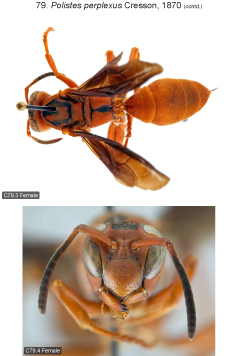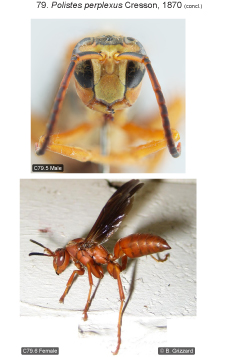
| Home | Table of contents | Keys | Species list | Glossary | Image data | PDF | Cite this article | Feedback | Updates |
Identification Atlas of the Vespidae (Hymenoptera, Aculeata) of the northeastern Nearctic region
CJAI 05, February 19, 2008
doi: 10.3752/cjai.2008.05
Matthias Buck, Stephen A. Marshall, and David K.B. Cheung
Department of Environmental Biology, University of Guelph, Guelph, Ontario, Canada N1G 2W1
Next species | Previous species | Key
79. Polistes perplexus Cresson, 1870
Figs B10.19, 20, 37, 48; C79.1–6.
 |

|
 |
Species recognition. This species is extremely similar to P. carolina with which it has been confused until fairly recently (Richards 1978, lists P. perplexus as a synonym of P. carolina). For characters distinguishing the two species see under P. carolina. Remarkably, the female of P. perplexus differs from all other species of the P. fuscatus-group by the entirely silvery pubescent malar space and gena (lower gena and malar space bare except for a few scattered setulae in other species). Overall, black markings seem to be better developed and yellow markings less developed than in P. carolina.
Variation. Fore wing length 18.0–21.5 mm (♀♀), 17.0–18.0 mm (♂♂, n = 3). Female. Body almost entirely ferruginous, with the following black to dark brown markings: spot around ocelli usually well developed, rarely divided into individual spots around each ocellus, spot in front of pronotal carina (often), scutum rarely largely black with posteriorly confluent ferruginous median and ferruginous lateral stripes, large anteroventral area of mesopleuron in two specimens, some mesosomal sutures and central stripe of propodeum. Yellow markings absent except sometimes on propodeal valves and tarsi. Male differs from female as follows: yellow markings better developed including face up to ocular sinus, anterior surface of pronotal carina, small anteroventral spots of mesopleuron, anterior corners of metanotum, coxae (hind coxae only with small spots), anterior surface of femora and tibiae (usually more or less suffused with ferruginous); yellow areas of metasomal sterna not observed due to poor condition of specimens. Black areas of scutum, mesopleuron and metapleuron more extensive than ferruginous areas in all three males examined (one male has the scutum nearly entirely black).
Distribution. Not recorded from Canada. Eastern U.S.: PA (new state record: 1 ♂, locality not given, DEBU) and MD to GA, west to southern IL, KS, OK and TX (Krombein 1979).
Biology. Nests in sheltered areas such as hollow trees, under wooden platforms and inside storage buildings (Wade and Nelson 1978). Biology otherwise poorly known due to confusion with P. carolina. Some biological references for that species likely pertain to P. perplexus.
Next species | Previous species | Key
| Home | Table of contents | Keys | Species list | Glossary | Image data | PDF | Cite this article | Feedback | Updates |
